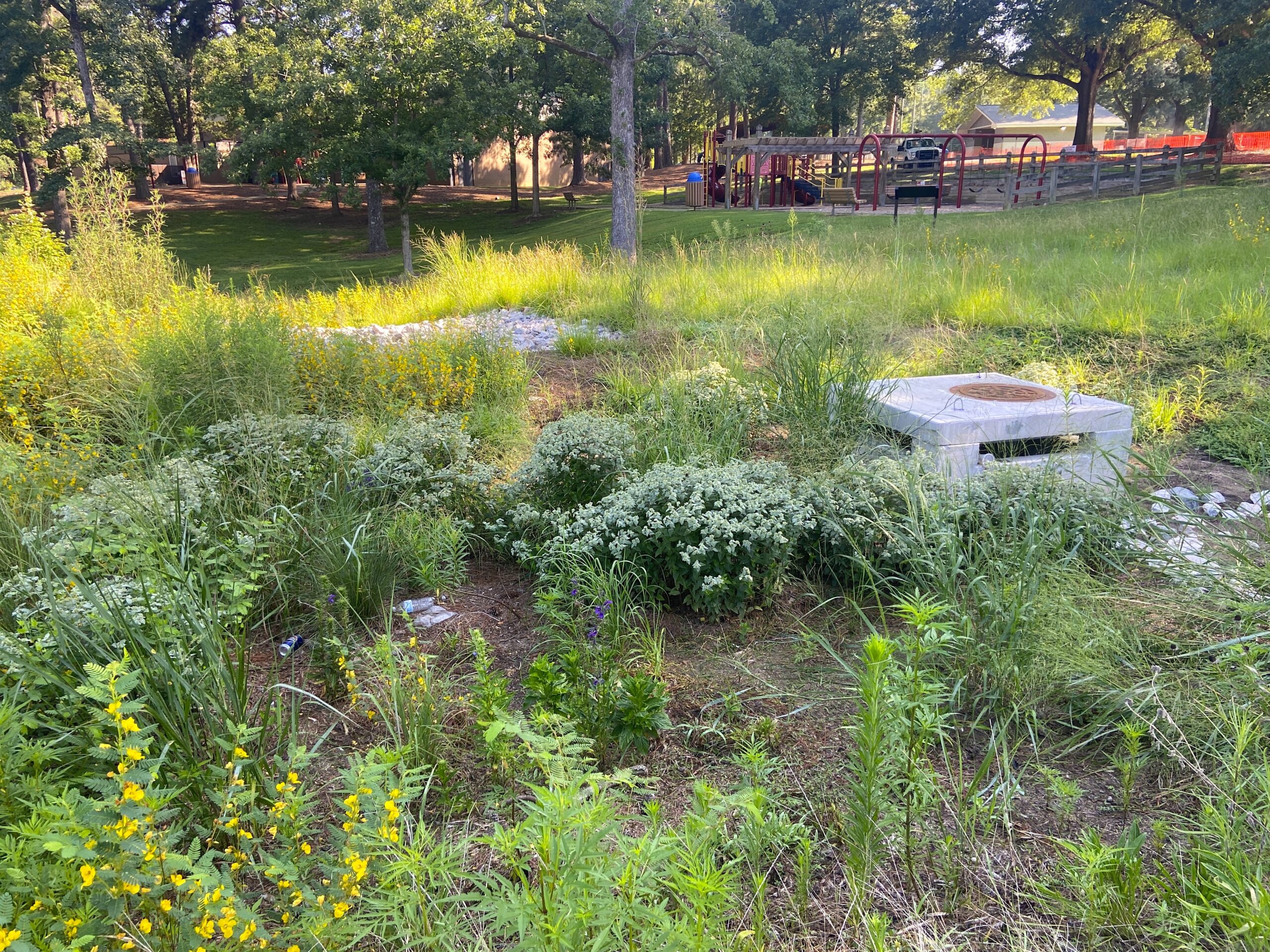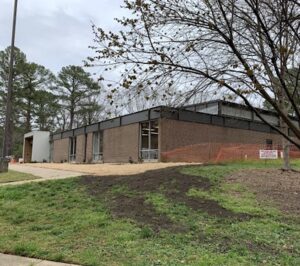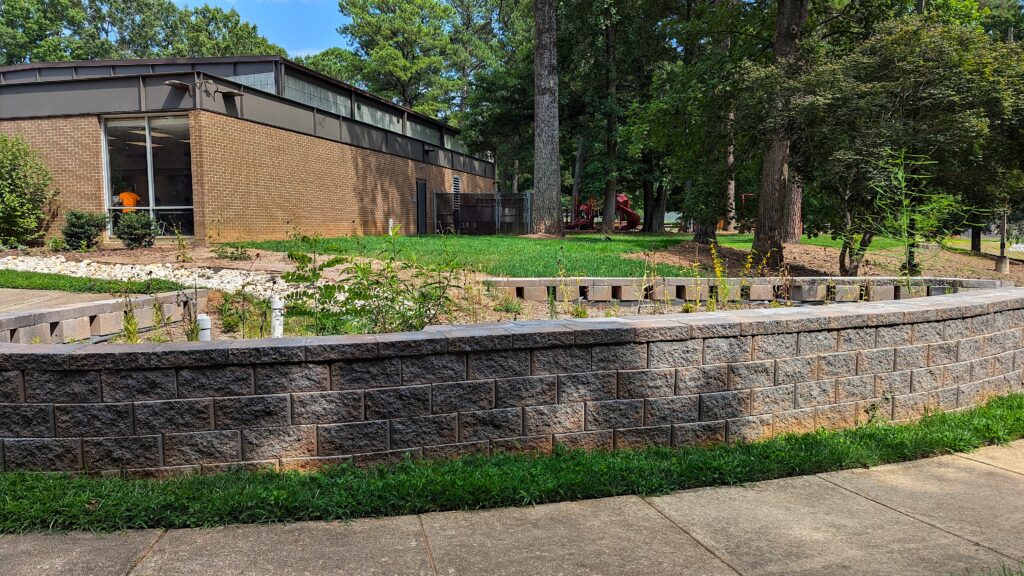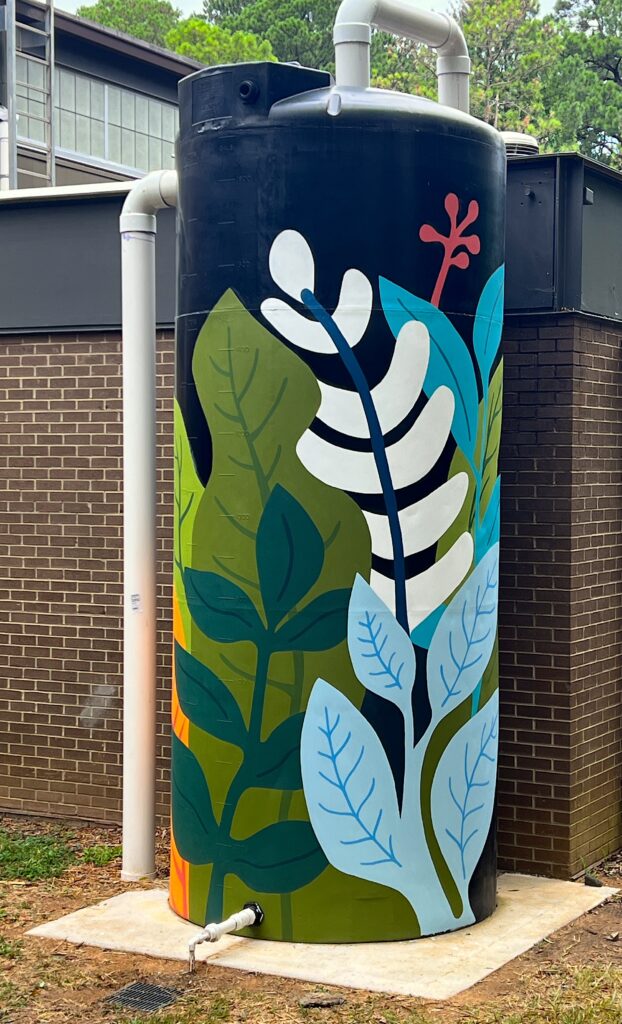Green Solutions at Biltmore Hills Park
Reducing Stormwater Runoff for Rochester Heights Creek

“You lay awake and you think, Lord, when it storms, is that creek going to feed back up and be worse this time? It’s scary, but I will not leave this area. I was born and raised here in my family’s house. I am living in the house I was raised in, my kids were raised in. My grandkids are coming up in it.”
— Julia Kay Daniels, Rochester Heights resident
from the Raleigh Stories Public Art Project
Two miles south of downtown Raleigh, in a neighborhood of townhomes and single-family homes, a small creek starts inauspiciously, growing in size as it flows along the edge of Raleigh’s Biltmore Hill Park and underneath the ten lanes of I-40, where the interstate bisects two historic neighborhoods created for African Americans in the late 1950s and early 1960s: Rochester Heights and Biltmore Hills.
While the origins of “Rochester Heights Creek” are modest, its impacts are outsized, carrying the stormwater runoff from nearby roads, parking lots, and buildings. During heavy rain events, this creek — which has no official name in the state’s records — swells and rages, carving dirt out of the streambanks as it turns corners, rising up over the banks behind homes in Rochester Heights, flooding backyards and street intersections, lapping at foundations.
Under the direct force of Hurricane Fran in 1996, runoff from the stream met rising waters from Walnut Creek to cause catastrophic flooding of homes within and closest to the floodplain. The specter of that flood has lingered in Rochester Heights, helping to spur the formation of Partners for Environmental Justice (PEJ) out of St. Ambrose Episcopal Church.


Where Rochester Heights Creek flows into Walnut Creek, PEJ and its many partners advocated for the protection of the Walnut Creek Wetlands to safeguard the stormwater solutions that the wetlands provide during heavy storms. However, the amount of stormwater runoff flowing into Walnut Creek — and thus backing up into this little feeder creek — has only increased with upstream development and with increasingly intense storms fueled by warming ocean waters.
North Carolina Sea Grant and the NC Water Resources Research Institute (WRRI) began supporting PEJ’s mission of empowering communities and protecting ecosystems in 2014 after PEJ’s founding chairperson Norman Camp and the NC State College of Humanities and Social Sciences’ Deidre Crumbley hosted a forum at NC State for the academic community. On behalf of WRRI and Sea Grant, I teamed with Louie Rivers from NC State’s College of Natural Resources to share leadership of the resulting collaboration — the Walnut Creek Wetlands Community Partnership — which included support from the national non-profits American Rivers and The Conservation Fund, as well as participation from PEJ, City of Raleigh, St. Ambrose Church, and other groups.

Green Solutions for Stormwater Runoff
Early discussions with neighbors during focus groups and through a survey of community members showed continued evidence and concern for flooding. There also was the need to build trust between a local government with a history of discrimination and neglect of Black neighborhoods and community members who have experienced past injustices, such as dumping and inequitable charges for stormwater management.
In 2019, WRRI and Sea Grant’s Grace Fullmer created a small watershed plan for Rochester Heights Creek. The focus area plan became part of the Walnut Creek Watershed Action Plan, which the North Carolina Dept. of Environmental Quality also hosted online. During this rapid planning process, discussions with some of the residents who lived next to the creek provided support for focusing on upstream contributors to stormwater runoff.
Because Biltmore Hills Park was constructed well before requirements for managing stormwater, it was a logical place to start the watershed improvement effort. By this time, the City of Raleigh’s Stormwater Department and the city’s Department of Parks, Recreation and Cultural Resources were already participating in the Partnership and listening to community concerns about the creek. So, in late spring of 2020, while most people were working out of their homes due to the COVID pandemic, a team sported face masks to walk the extent of Biltmore Hills Park, searching for viable locations to disconnect “impervious surfaces” (such as rooftops, parking lots, and roads) from immediate pathways for stormwater to the adjacent creek.

They focused on the eastern side of the park, because the western edge was undergoing planning for new tennis courts that also included green infrastructure to reduce the new facility’s runoff.
For the park’s eastern side, the team identified a series of potential green stormwater infrastructure (GSI) projects that could intercept and treat runoff from the community center, playground, picnic area, and upper parking lot. As opposed to piped drainage systems, green infrastructure mitigates stormwater at its source while delivering environmental, social, and economic benefits. GSI typically uses vegetation, soils, and other elements and practices to restore some of the natural processes required to manage water and create healthier urban environments. At the city or county scale, green infrastructure is a patchwork of natural areas that provides habitat, flood protection, cleaner air, and cleaner water. At the neighborhood or site scale, GSI mimics nature to slow, soak up, and store stormwater.
From Dreams to Reality
The EPA and the City of Raleigh provided support for the project’s green stormwater solutions. Kris Bass Engineering began the design, while WRRI and Sea Grant began engaging community members at outdoor events about GSI (which, in this case, began by emphasizing the importance of trees). Site design led to design review, design review led to construction drawings, and construction drawings moved through City and State permitting and review.
Along the way, I facilitated monthly team meetings to provide a regular forum for partners to ask questions and check in with one other. Many topics arose, including:
• What do we do about the electric line traversing our project area? (The City of Raleigh will pay Duke Energy to move it.
• Do we remove our largest “bioretention area” (an engineered rain garden) from the proposed scope of work, because the lowest contractor bid was still higher than our budget? (Yes, for now, but let’s find more funding and return it.)
• How would we navigate through the complications of seemingly never-ending surprises of on-site utilities? (We rely on the City of Raleigh’s construction project engineer Desmond Whitfield.)


This complicated GSI project — the most complex that I’ve overseen — succeeded with a highly collaborative team navigating issues that surfaced at every step. When pandemic-induced inflation took a bite out of the budget, the team sought and won additional funding to implement the entire vision for the park through a second grant from the NC Department of Justice’s Ecosystem Enhancement Grant program. When all the contractor bids came in over budget, City of Raleigh’s project liaison, Amy Farinelli, worked with the Stormwater Department to obtain additional cost share funds to close the gap and hire the contractor with the lowest bid, Fluvial Solutions, Inc.
This additional support enabled the installation of all of the stormwater control measures for Biltmore Hills Park. A bioretention area, swale, and two cisterns treat runoff — quite beautifully and visibly — at the Biltmore Hills Community Center. Other bioretention areas include two large ones visible from the community pool and a new stabilized conveyance that replaces a previously eroded ditch in the center of the park. An additional bioretention area and a stabilized roadway conveyance are now in place at the park entrance.
Raleigh Arts, the City’s public arts division, joined the team to help invite local artists to submit applications to design and paint murals on the rainwater harvesting cisterns. Chris Burwell, the park director, shared the submitted illustrations with park users to select a design that resonated with community members. Local artist Adriana Ameigh’s dreamy and colorful botanical murals were the community favorites and now provide vibrant images for parkgoers to enjoy while picnicking or playing on the nearby playground. In addition, informational signs about bioretention and rainwater harvesting inform visitors about the park’s green stormwater infrastructure.
Successes — And What’s Next
As intended, the completed green stormwater projects reduce the volume of runoff and associated pollution entering the creek flowing through the Biltmore Hills and Rochester Heights neighborhoods.

Reductions in the amounts of nitrogen (by 64%) and phosphorus (by 60%) that enter the creek each year provide benefits to downstream Walnut Creek, the Neuse River, and its estuary. In excess, these nutrients can promote algal blooms and cause groundwater contamination, both of which bring a variety of associated environmental and human health risks.
Most importantly for the downstream neighbors, annual stormwater runoff volume is down by 55% — a reduction of 155,814 cubic feet per year when precipitation falls as expected. Although this reduction in runoff alone cannot prevent flooding of downstream homes during large rain events, particularly because rising levels of Walnut Creek may contribute to this tributary’s water level, the new GSI does help reduce the impacts of more frequent rain events.
The project also shows where the “rubber meets the road,” as partners seek to install enough runoff-reduction projects throughout the watershed to reduce creek flows and flood risk.
Although we did face challenges, the project was ultimately successful in installing all of the GSI that we identified as feasible for the park, as well as providing multiple opportunities for community engagement and education. We hope it can serve as an inspirational model as our many partners work together to identify and implement additional projects to benefit people and the environment in this drainage area and the wider Walnut Creek Watershed. Already, our partners are engaging community members in seeking additional potential GSI project sites and streambank restoration opportunities.
I’m not a contractor, nor do I play one on TV or on YouTube. What I do have is a love for creating gathering spaces for people with neighborhood knowledge and concerns, lived experiences, and expertise — and the passion to come up with great ideas and make those ideas happen, together.
In addition to the people mentioned above, many others helped make this project a success: City of Raleigh employees Shawsheen Baker, Houston Jones, Kelly McChesney, Terry Naranjo, Megan Walsh, and Neil Wisenbaker; Kris Bass, Connor Brown and Carmen Tormey of Kris Bass Engineering; Peter Jelenevsky and the crew from Fluvial Solutions; Sea Grant Community Engaged Intern Alyanna Wilson; WRRI interns Darius Collins Jr. and Ezekiel Snyder; and Walnut Creek Stewardship Corps members Angela Daniel, Elena Fedorova, Alysia Richard, and Denise Spaugh. Partners for Environmental Justice initiated this important work in the watershed and has continued to empower community to move it forward.
More
Walnut Creek Watershed Action Plan
about the Walnut Creek Wetlands Community Partnership
about green stormwater infrastructure
about green stormwater infrastructure in Biltmore Hills
The Guide to Coastal Living on addressing stormwater runoff
Lead photo: A biorentention area filters stormwater and allows it to permeate the soil at Biltmore Hills Park — and it supports plenty of summertime pollinators. Credit: Christy Perrin.
Christy Perrin is the sustainable waters and communities coordinator for North Carolina Sea Grant and the NC Water Resources Research Institute. Her interests include helping public and private organizations enhance community development while protecting natural resources, particularly in historically underserved areas, and building capacity for collaborative leadership.
FROM THE FALL 2025 ISSUE
coming soon


